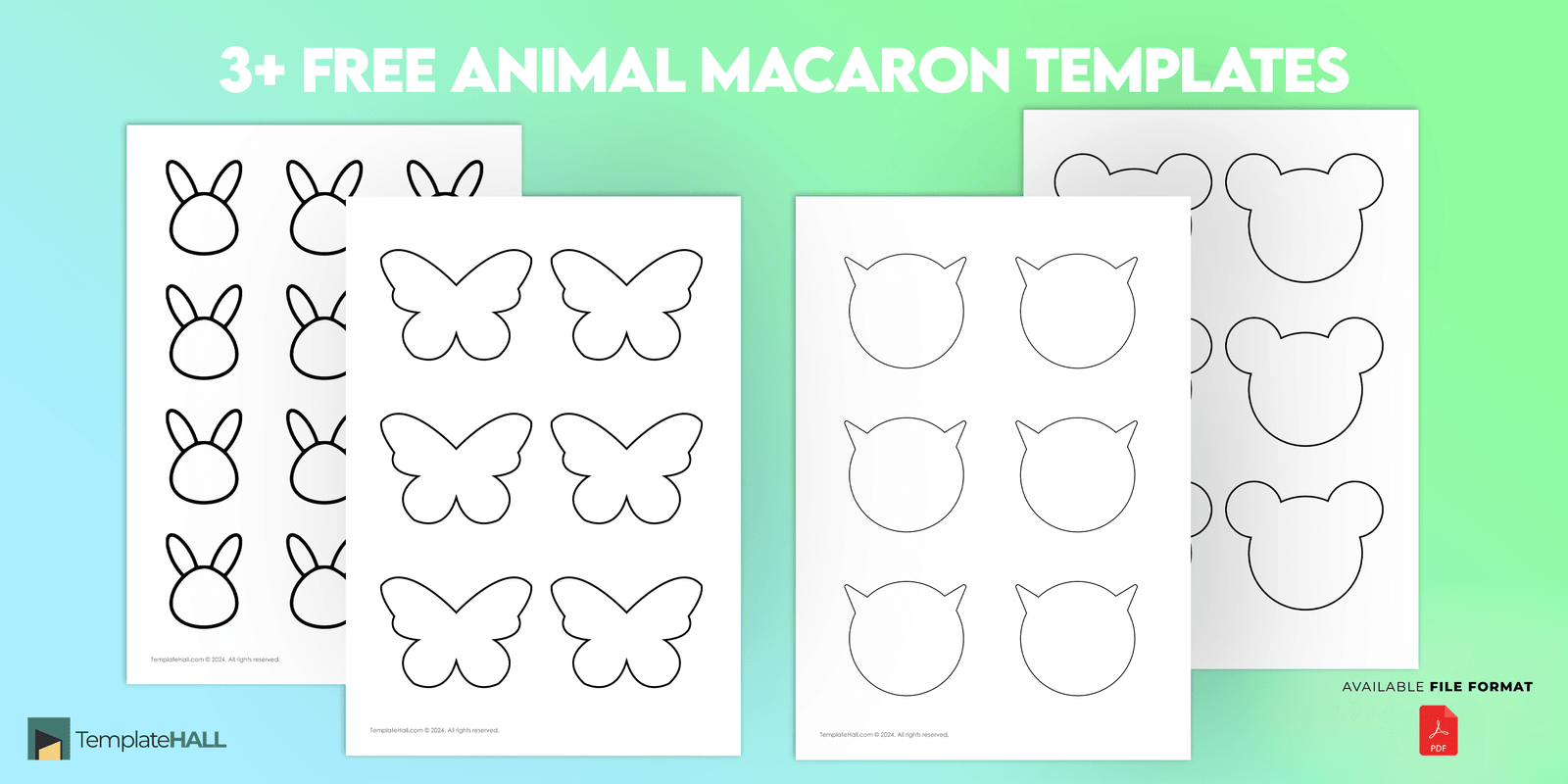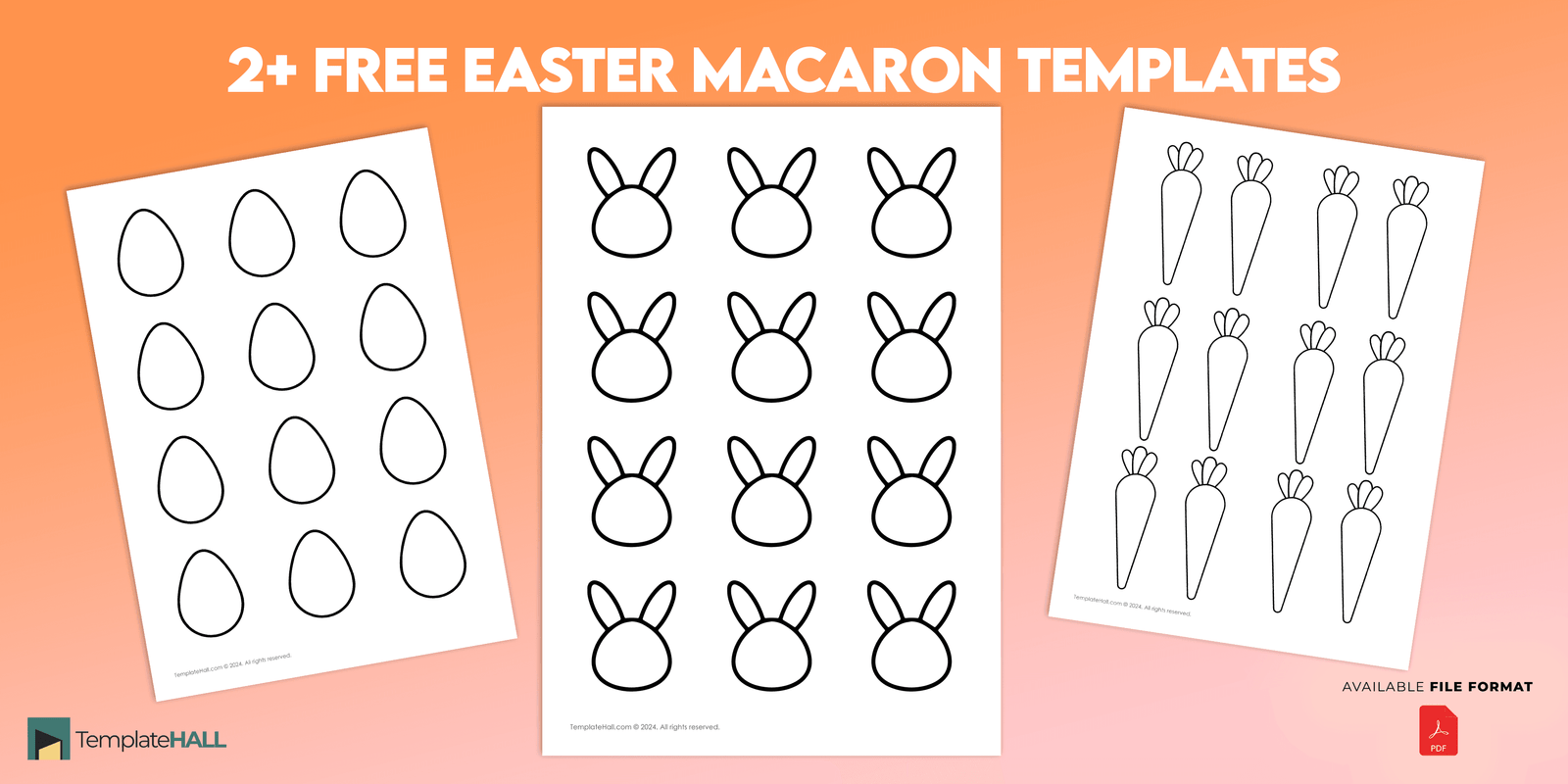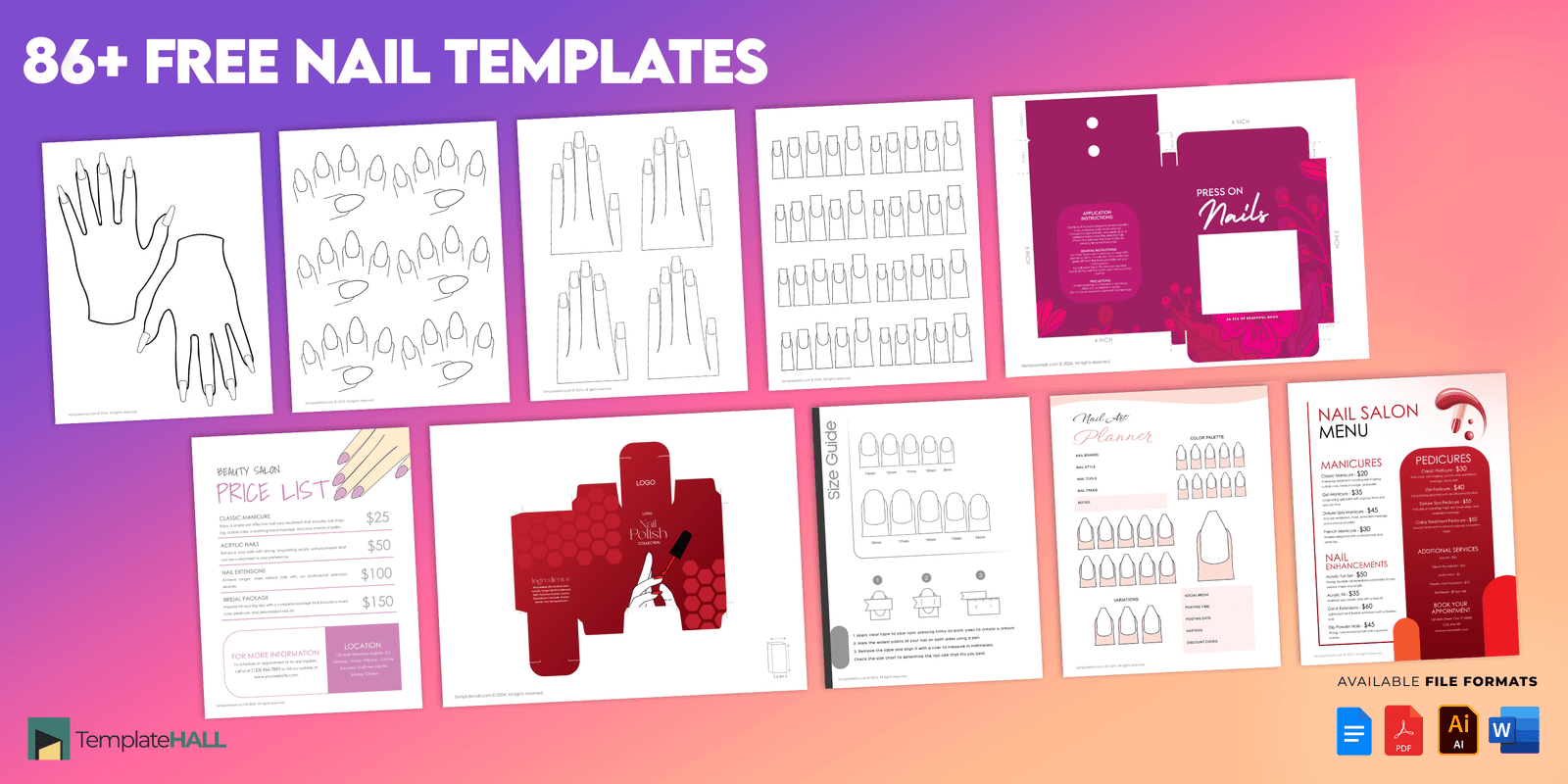Understanding intricate relationships, family dynamics, or multi-generational histories can feel daunting. Tracking patterns or organizing ancestry often leads to confusion and incomplete details without the right tools. A genogram template Word format offers a practical, customizable solution.
Imagine trying to piece together vital family or social connections without a clear, efficient system. This frustration wastes valuable time and limits your ability to analyze data, especially for social work studies, therapy, or genealogy projects. The inability to streamline such efforts can prevent you from uncovering meaningful insights.
These templates simplify the visualization of relationships, allowing users to easily modify, share, and print diagrams. This article explores various genogram templates, their applications, and tips to utilize them efficiently.
Table of Contents
Why Use a Genogram Template?
A genogram template Word is a powerful tool for mapping out complex relationships, family dynamics, and individual histories. With intuitive features, these templates become versatile, easy to use, and adaptable for various professional and personal purposes.
Here’s an expanded breakdown of why genogram templates are so effective:
1. Ease of Access
These templates are widely accessible, making them convenient for users across all levels of expertise. Microsoft Word is a standard software available on most devices, from desktop computers to tablets and smartphones. This accessibility ensures that users can work on their genograms anytime and anywhere.
Moreover, for those without Microsoft Word, compatible software such as Google Docs allows seamless access, ensuring no barriers to productivity.
2. Customization
Genogram templates provide exceptional flexibility, allowing users to tailor their diagrams to meet unique needs. Word’s built-in tools, such as shapes, text boxes, and color options, enable users to represent relationships, emotions, and dynamics with precision.
You can easily adjust the layout, add custom symbols, or modify fonts and colors to make the genogram more visually engaging and relevant to your purpose, whether for academic, clinical, or personal use.
3. Compatibility
One of the greatest advantages of these genogram templates is their compatibility. These templates can be easily saved in various formats, such as PDF, making them perfect for sharing with colleagues, clients, or family members.
This versatility ensures that your work can be viewed on multiple platforms without losing its quality or structure. Additionally, genograms created in Word can be integrated into presentations, reports, or research papers with ease.
4. Printable Formats
Whether you need a hard copy for a presentation, therapy session, or personal archive, genograms are printer-friendly. The ability to print directly from Word ensures that your diagrams maintain their clarity and structure.
This feature is particularly useful for professionals in fields such as social work, counseling, or education, where physical documentation is often required for meetings or case studies.
By using a genogram template Word, you gain a versatile, accessible, and professional way to visualize and organize complex information efficiently.
Types of Genogram Templates
Genogram templates come in various forms, each tailored to specific purposes, whether for analyzing family structures, understanding social dynamics, or exploring cultural roots.
Here’s an overview of the most common types and their applications:
1. Blank Genogram Templates
A blank genogram template is a simple and versatile starting point for creating a detailed diagram. These templates typically include basic symbols such as circles for females and squares for males, connected by lines that denote relationships.
Detailed Uses:
- Track family medical history to identify patterns of inherited conditions.
- Create tailored charts for therapy sessions or academic studies.
- Visualize evolving relationships over time, such as marriages or divorces.
Key Features:
- Free to download.
- Available in Word, PDF, and Google Docs formats.
- Printable and customizable.





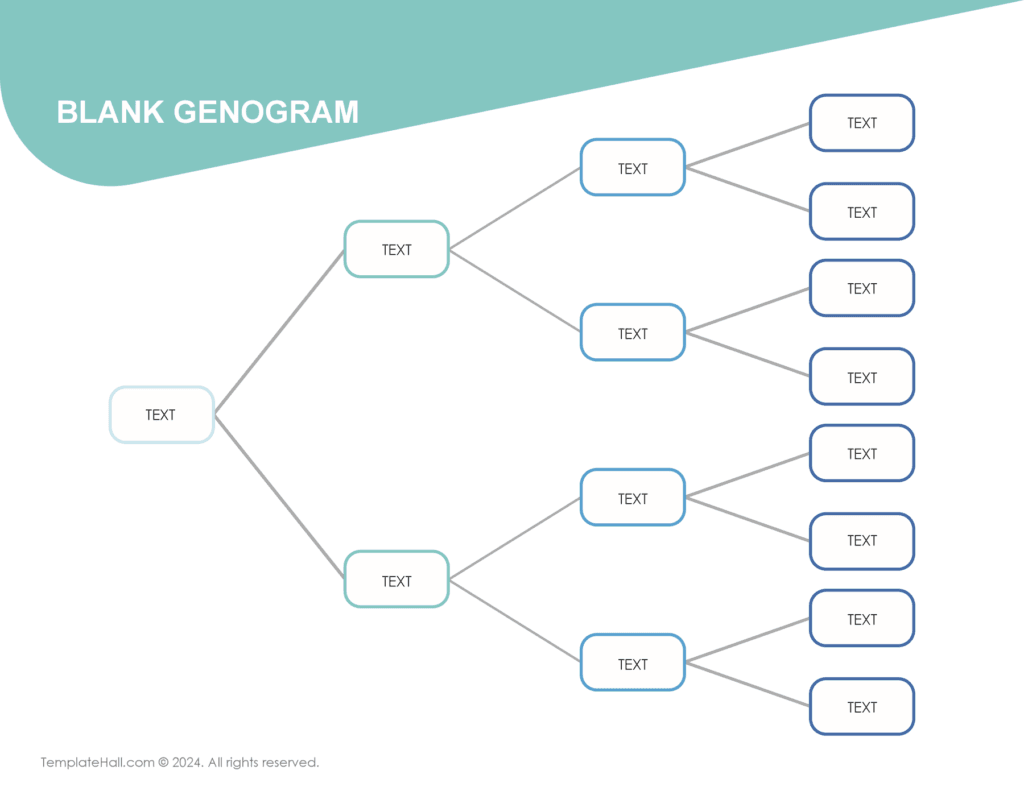




2. Family Genogram Templates
Family genogram templates focus on mapping out family relationships across generations. These templates highlight connections such as marriages, divorces, and sibling relationships, along with emotional dynamics like conflict or closeness.
Detailed Uses:
- Analyze familial conflicts or emotional bonds for therapy.
- Record lineage for genealogical studies.
- Identify patterns of behavioral traits across family generations.
Key Features:
- Available as a free download in Microsoft Word and PDF formats.
- Designed for detailed family analysis.
- Printable and editable.
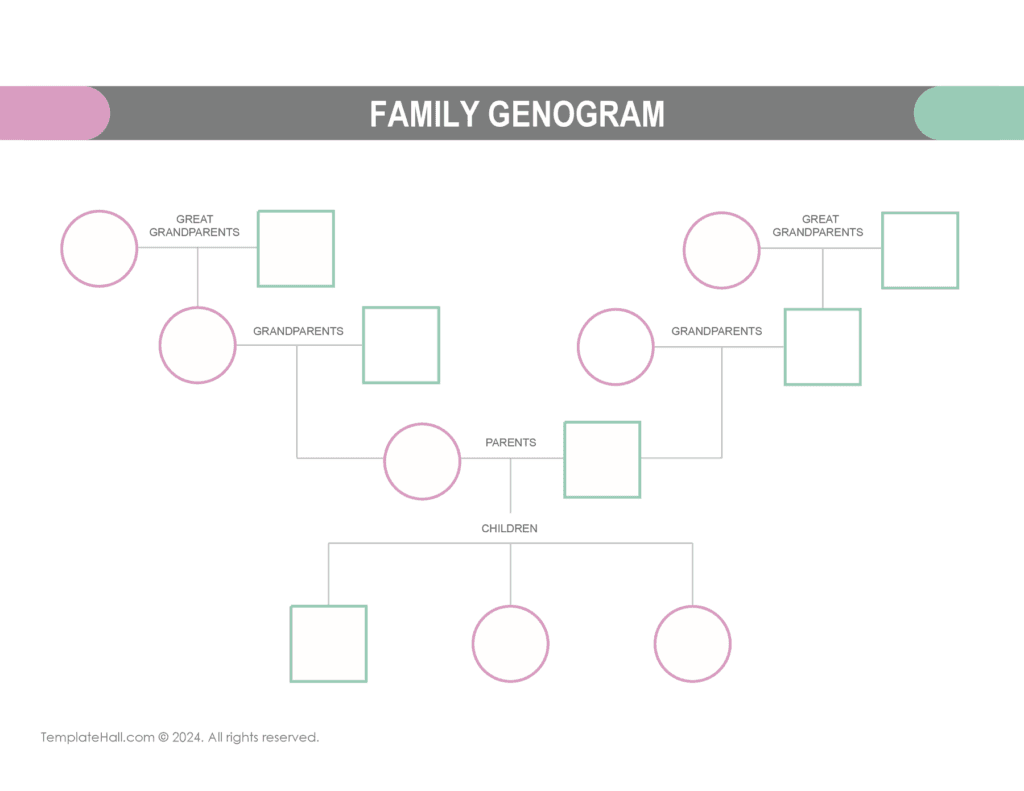




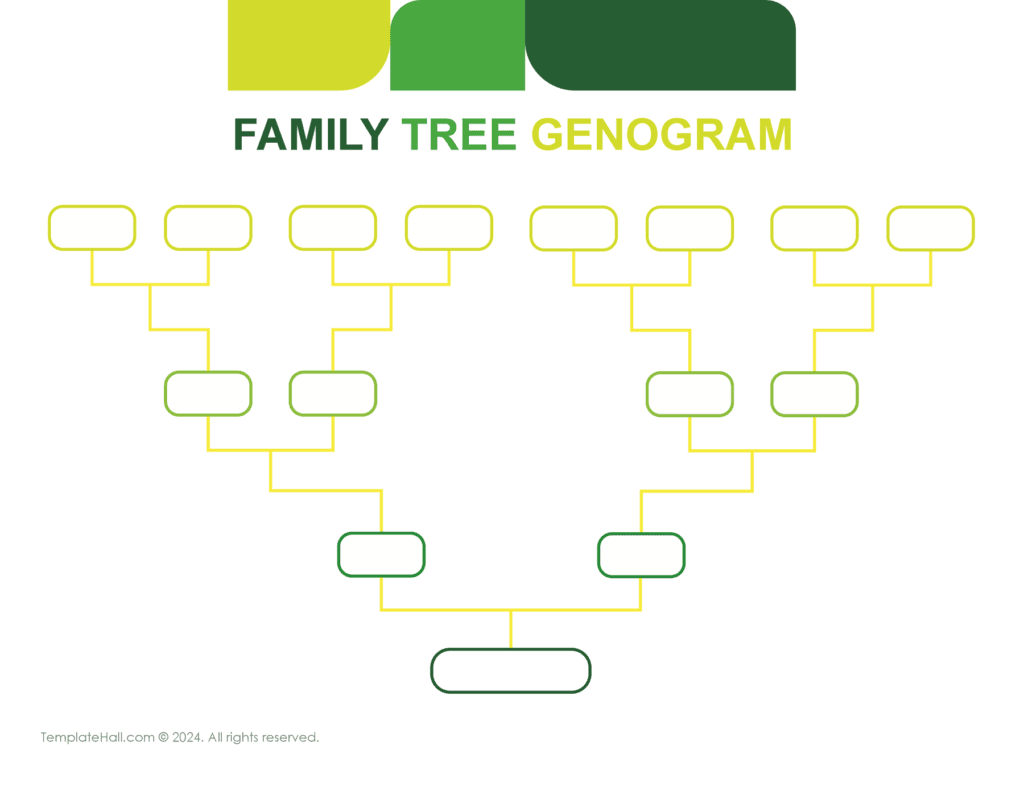




3. 3-Generation Genogram Templates
These templates are structured to visualize three generations of family or social connections. They’re widely used for academic purposes or personal projects.
Detailed Uses:
- Discover hereditary health risks by analyzing three generations.
- Visualize patterns of addiction, trauma, or mental health conditions.
- Educate students in social work or family counseling courses.
Key Features:
- Blank and pre-filled options are available.
- Downloadable in Word, PDF, and Google Docs formats.
- Printable and adaptable for individual needs.






4. Social Work Genogram Templates
Social work genograms emphasize relationships beyond family, including friends, colleagues, and community influences. These templates are designed to track emotional, professional, and societal dynamics.
Detailed Uses:
- Document client relationships for social work assessments.
- Analyze the influence of external factors like schools or workplaces.
- Map out community support structures for rehabilitation programs.
Key Features:
- Available online as printable resources.
- Comes in Word and PDF formats for easy customization.
- Includes symbols for various types of relationships.
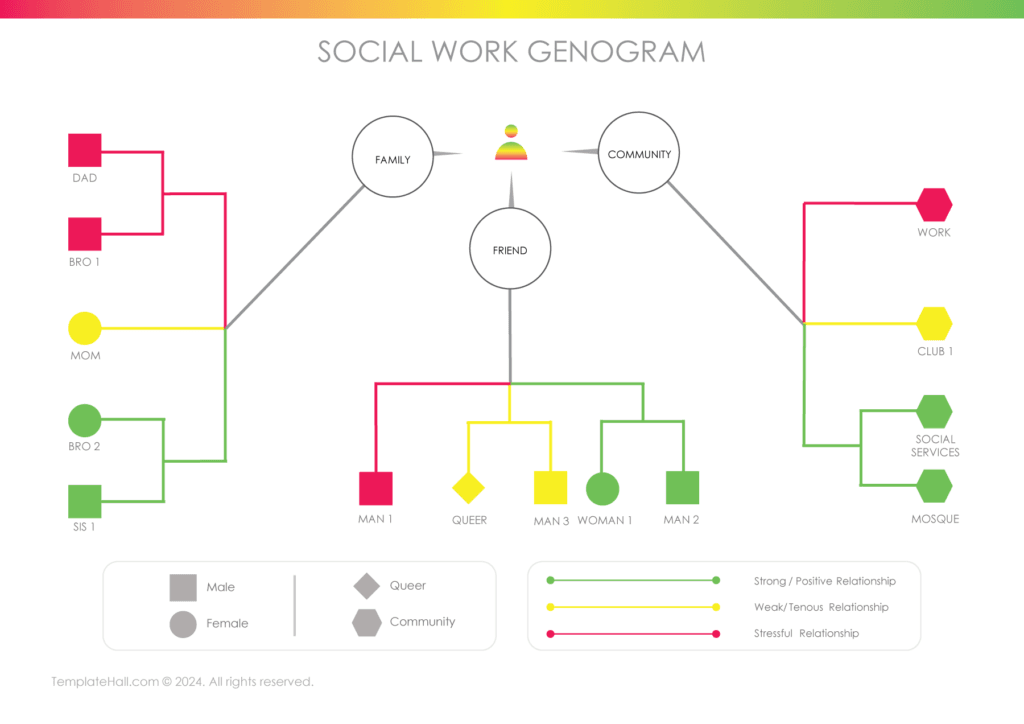




5. Career Genogram Templates
Career genograms document professional histories and career paths within a family or organization. These career genogram templates are great for tracking occupational trends and inspirations.
Detailed Uses:
- Explore generational career influences for educational counseling.
- Understand workplace dynamics and professional growth trends.
- Plan career paths using historical career insights within a family.
Key Features:
- Downloadable in Word and PDF formats.
- Printable and editable for presentations.
- Includes symbols for various professions.





6. Cultural Genogram Templates
Cultural genogram templates focus on the ethnic, cultural, and geographical backgrounds of individuals. They’re used to highlight the diversity and cultural influences in family histories.
Detailed Uses:
- Explore multicultural influences on upbringing and values.
- Visualize migration patterns for historical or sociological studies.
- Celebrate cultural diversity within family trees.
Key Features:
- Free templates are available for download.
- Compatible with Word, Google Docs, and PDF formats.
- Printable and easily customizable.





7. 4-Generation Genogram Templates
These templates expand upon the three-generation genograms, adding a layer of detail to cover great-grandparents and other extended family members.
Detailed Uses:
- Study hereditary diseases and genetic predispositions.
- Document extensive family histories for reunions or archives.
- Create a visual narrative for storytelling or historical records.
Key Features:
- Blank templates are available for detailed customization.
- Free to download in Word and PDF formats.
- Printable for family archives or academic purposes.

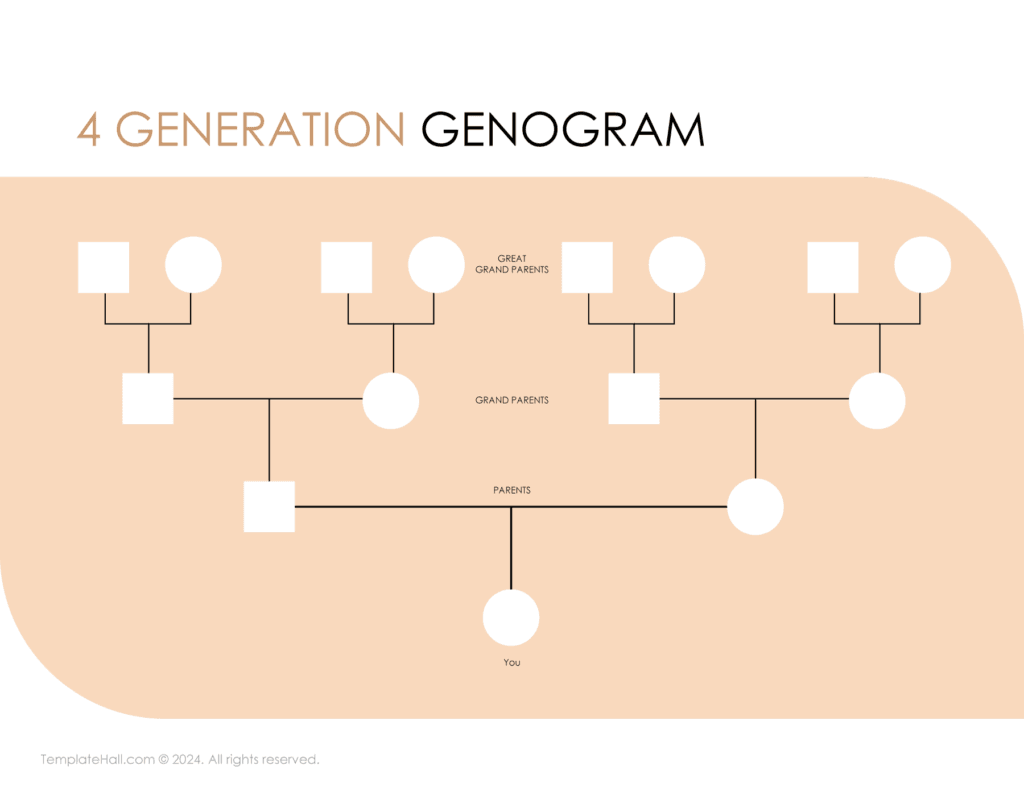

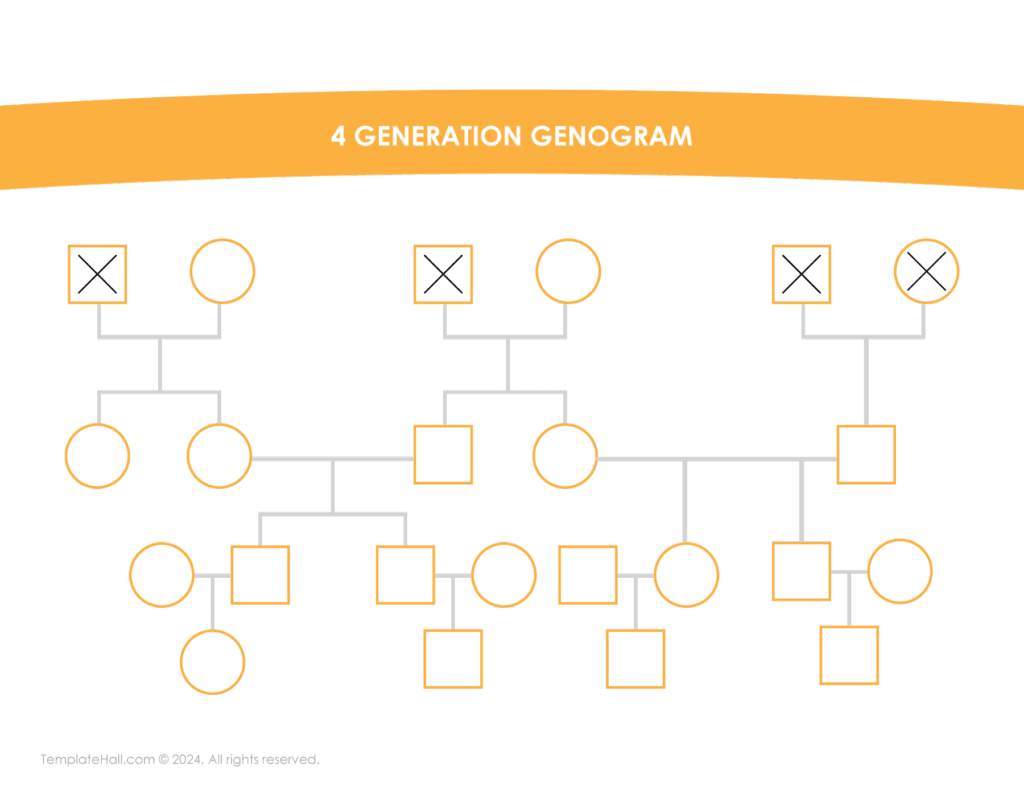
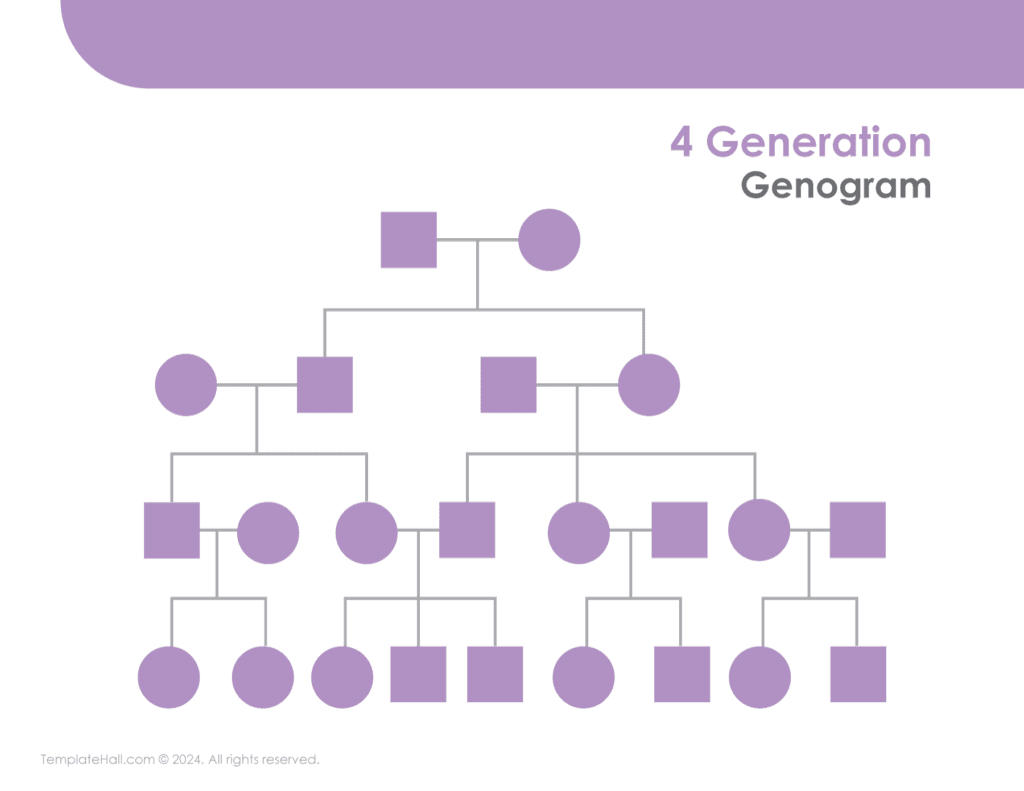
8. Addiction Genogram Templates
Addiction genograms track patterns of addiction, substance abuse, and recovery across generations or within a social circle. These templates are invaluable for therapists and recovery professionals.
Detailed Uses:
- Map patterns of substance use and identify risk factors.
- Aid in intervention planning and family therapy sessions.
- Track recovery journeys for motivational purposes.
Key Features:
- Available in Word and PDF formats.
- Free online resources for download.
- Printable templates with specific symbols for types of addiction.


How to Use a Genogram Template in Word
Creating a genogram template Word is a straightforward process that combines the convenience of pre-designed templates with the flexibility of customization. Whether you’re using it for family research, therapy, or academic work, following these steps will ensure a seamless experience.
Here’s a detailed guide:
Step 1: Download the Template
The first step is to find and download a genogram template that meets your specific needs. Websites specializing in templates, such as TemplateHall, offer a variety of free resources in Word, Google Docs, and PDF formats.
Before downloading, review the features and structure of the template to ensure it aligns with your project requirements. For example, some templates may focus on family dynamics, while others are tailored for professional use in social work or therapy.
Step 2: Customize the Template
Once the template is downloaded, open it in Microsoft Word. Use built-in tools, such as shapes, text boxes, and formatting options, to personalize the genogram. Add names, ages, and symbols to represent individuals and their relationships.
You can also use colors and lines to denote emotional connections, such as closeness or conflict, and add notes to highlight key details. This step allows you to tailor the genogram to your purpose, whether it’s for understanding family patterns or analyzing social dynamics.
Step 3: Save and Share
After customizing your genogram, save it in Word format to keep it editable for future updates. If you need to share the genogram with others, such as clients, colleagues, or family members, convert it to a PDF format.
PDFs preserve the formatting and structure, ensuring that the document appears professional and consistent on any device. Many platforms also allow for easy sharing, enabling seamless collaboration.
Step 4: Print Your Genogram
If a physical copy is required for presentations, documentation, or archival purposes, use the printable option in Word. Ensure that your genogram is properly aligned and formatted before printing to maintain clarity and readability.
Printing is particularly useful for in-person meetings, therapy sessions, or classroom discussions, where tangible documents facilitate engagement and understanding.
By following these steps, you can efficiently create and utilize genogram templates in Word, ensuring a professional and personalized outcome for any project.
Simplifying the Genogram Creation Process
Creating a genogram doesn’t have to be overwhelming. With the right approach and tools, you can streamline the process and ensure your genogram is accurate, meaningful, and easy to interpret.
Here are some tips to simplify the creation process and get the most out of your genogram templates:
1. Choose the Right Template
Selecting the right template is the foundation of a successful genogram. Consider your objectives before deciding on a template type. For instance, if you’re analyzing family dynamics, a Family Genogram Template would be ideal.
If your focus is on exploring cultural roots or social influences, opt for a Cultural or Social Work Genogram Template.
Choosing a template that aligns with your goals ensures that the structure and features meet your specific needs, saving time and effort.
2. Use Software Tools
Leverage the features of Microsoft Word or online platforms to customize your genogram efficiently. Word offers tools like shapes, text boxes, and color options to personalize your diagram. Online platforms often provide drag-and-drop functionality, which can be even more intuitive for beginners.
Whether you’re adding symbols, adjusting layouts, or inserting additional information, software tools can help you create a professional and visually appealing genogram without any technical expertise.
3. Incorporate Additional Notes
Enhance the depth and context of your genogram by adding detailed notes. These can include explanations of relationships, significant events, or historical insights. For example, if your genogram tracks patterns of addiction, note the triggers or treatment milestones alongside the corresponding individuals.
These annotations not only provide clarity but also make the genogram more informative for professional or academic analysis.
4. Seek Expert Guidance
If you’re using genograms for professional purposes, such as therapy, social work, or counseling, consider consulting with an expert. Social workers, genealogists, or therapists can provide valuable insights into best practices and ensure that your genogram accurately represents the intended relationships and dynamics.
Their expertise can also help you interpret the information effectively, making the genogram a more powerful tool for analysis and decision-making.
By following these tips, you can simplify the genogram creation process while enhancing its accuracy and relevance, making your work more effective and impactful.
Conclusion
A genogram template Word format is an invaluable tool for visualizing complex relationships, tracking histories, and analyzing patterns.
Whether you’re working on a family tree, exploring career influences, or analyzing social connections, these templates provide a structured and efficient way to present data. With options ranging from blank genograms to specialized templates for social work and addiction, there’s a genogram template for every need.
Download your free genogram template in Word today and start mapping your story!
FAQs
A genogram template is a pre-designed framework that helps you map out family relationships, histories, and dynamics visually. It includes symbols and lines to represent individuals and their connections, making it easier to analyze patterns and trends.
Using a genogram template in Word is convenient because Word is widely accessible and provides customization tools. You can easily modify the layout, add details, and share or print your genogram for various purposes.
Yes, our website offers free genogram templates in formats like Word, PDF, and Google Docs. These resources are perfect for personal, academic, or professional use.
Absolutely. Genogram templates are highly customizable. You can adjust shapes, colors, and labels to represent unique relationships and add notes for additional context.
There are various types, including Blank, Family, Social Work, Career, Cultural, 3-Generation, 4-Generation, and Addiction genograms. Each template serves specific needs and can be adapted to suit your goals.
Once completed, you can save your genogram in Word or convert it to a PDF for easy sharing via email or other digital platforms. Sharing in PDF ensures the formatting remains intact
Yes, genograms created in Word are printer-friendly. You can print them directly for use in presentations, therapy sessions, or as part of documentation.
You can find free genogram templates on websites offering professional resources, such as platforms like TemplateHall. These are available in Word, Google Docs, and PDF formats.




